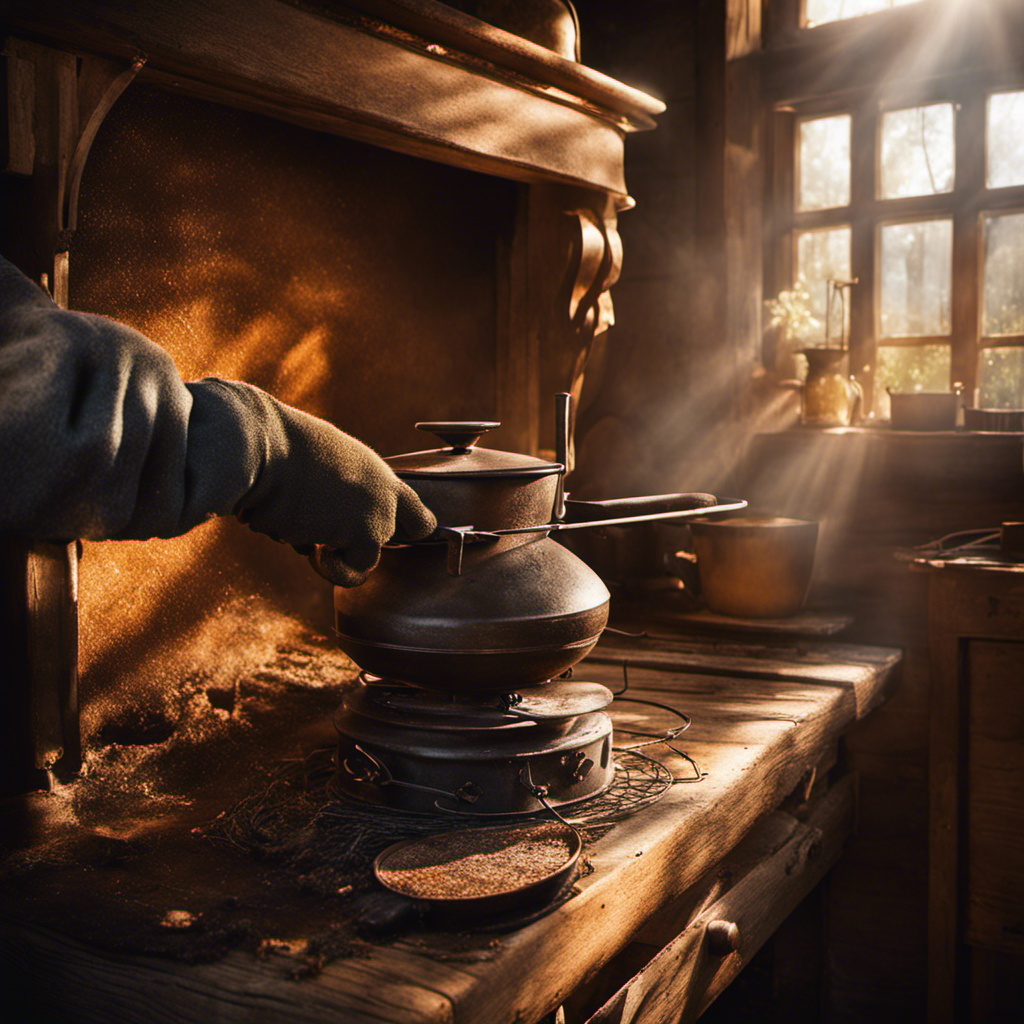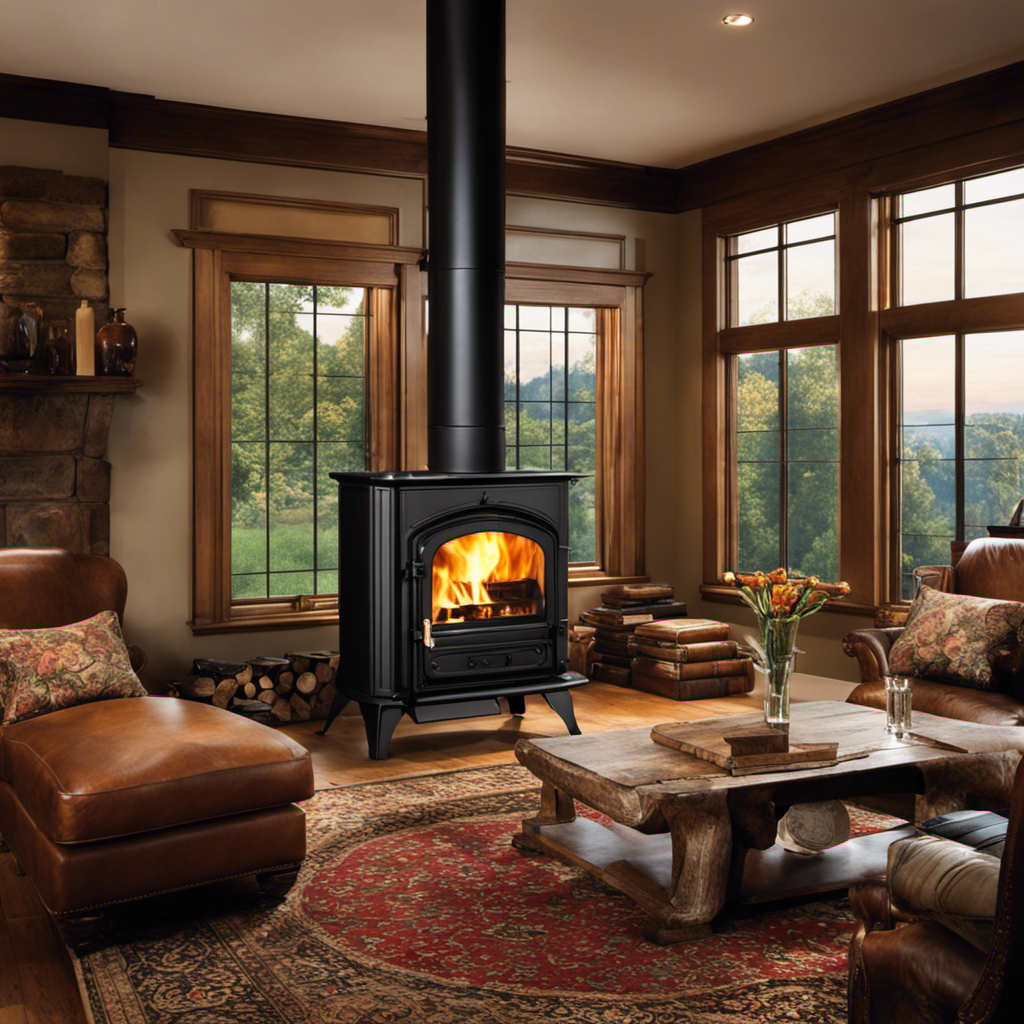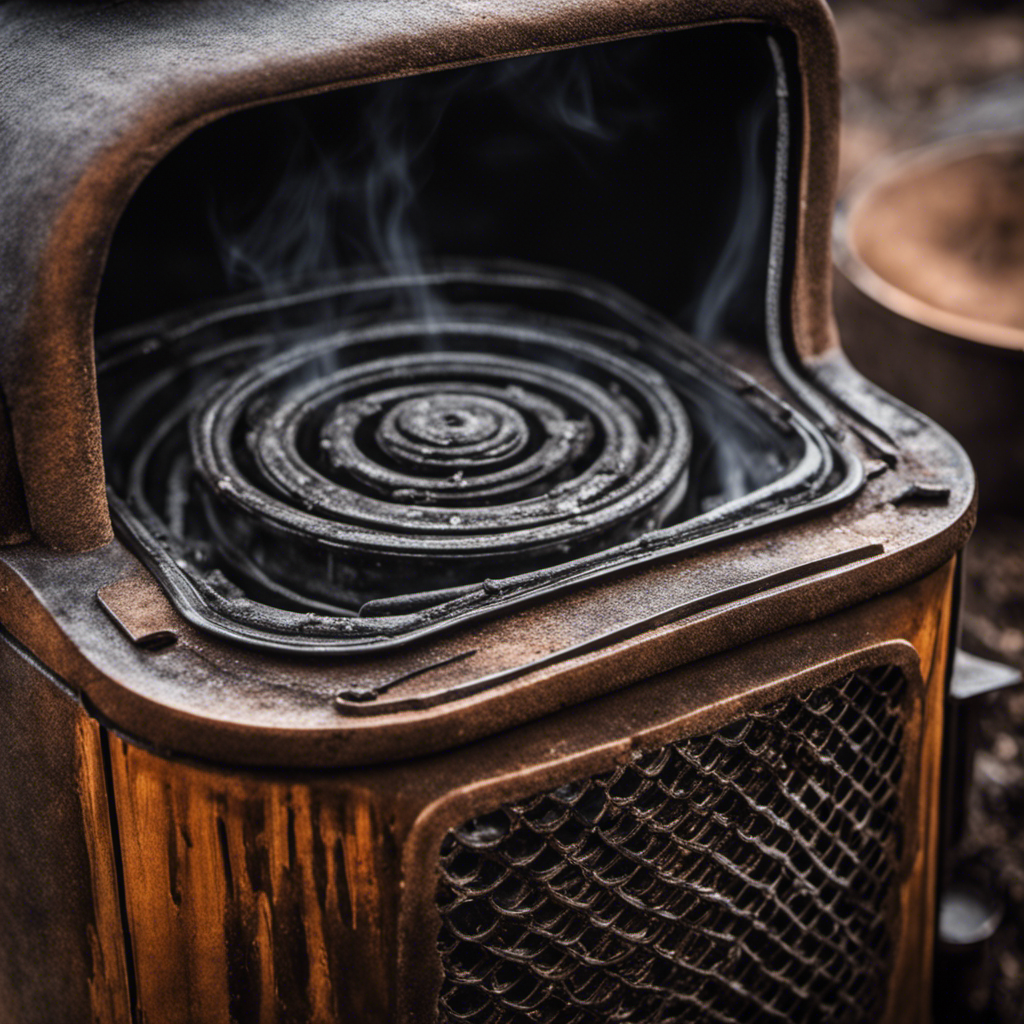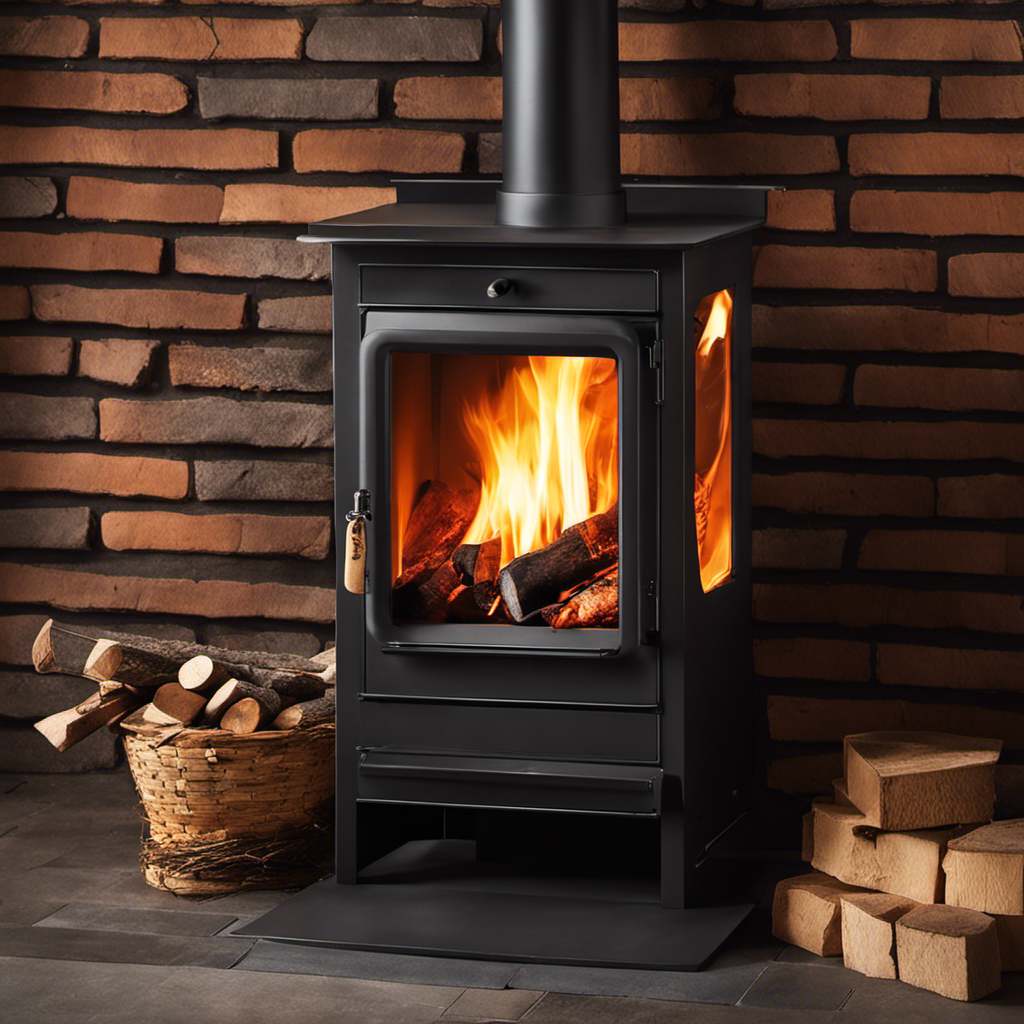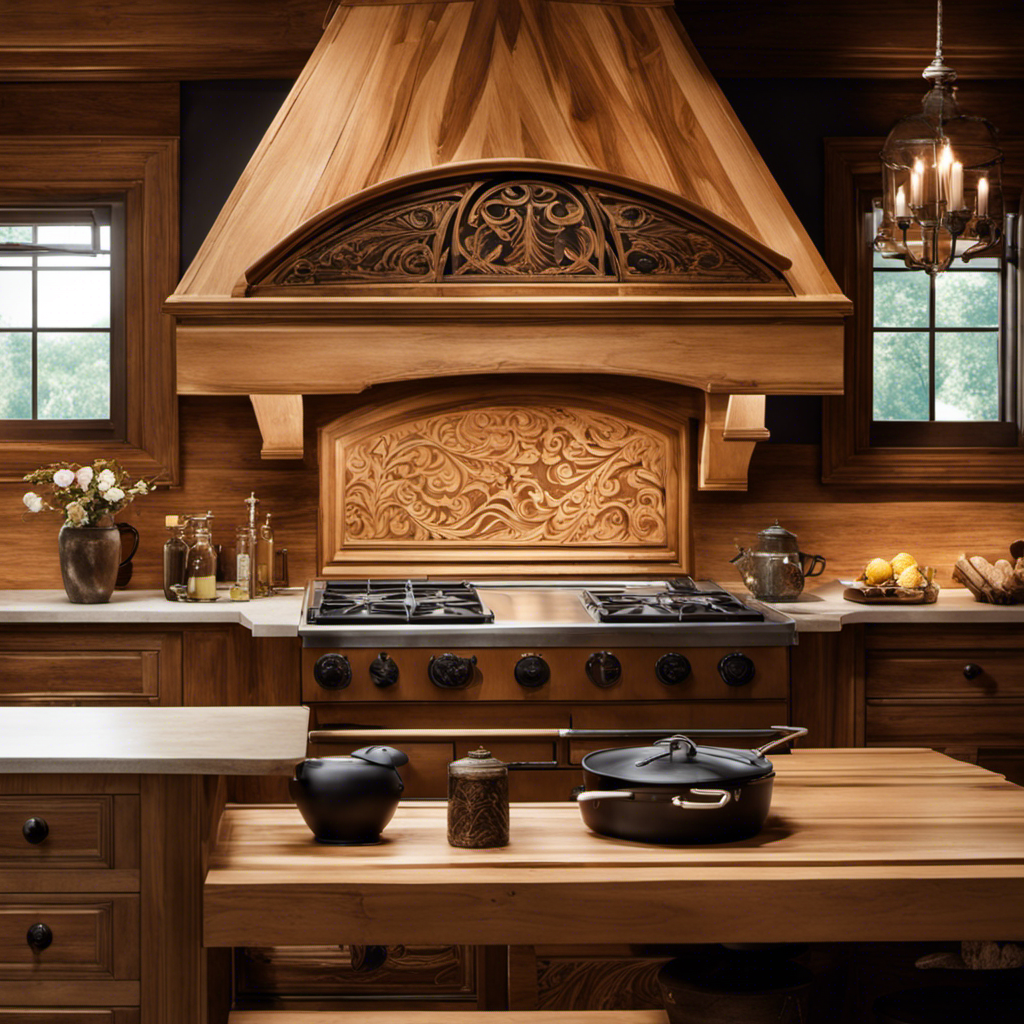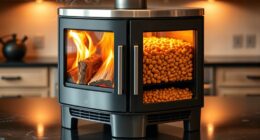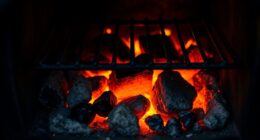As someone who uses a wood stove regularly, I can relate to the annoyance that rust can bring. It feels like a stubborn stain that never wants to disappear.
But fear not! In this article, I’ll show you the most effective methods to clean rust off your wood stove.
From natural remedies to chemical solutions, I’ve got you covered.
Plus, I’ll share some maintenance tips to prevent future rust.
Get ready to restore your wood stove to its former glory!
Key Takeaways
- Rust on a wood stove is caused by the reaction between iron or steel, oxygen, and moisture.
- Regularly wiping down the stove and applying a protective coating can help prevent rust.
- Natural remedies such as vinegar, lemon juice, and baking soda can be used to remove rust from a wood stove.
- Chemical solutions designed for wood stoves provide a gentler approach to rust removal compared to abrasive methods.
Understanding the Causes of Rust on a Wood Stove
I frequently notice rust on my wood stove, and I want to understand its causes.
Rust on metal surfaces, including the wood stove, is primarily caused by the reaction between iron or steel and oxygen in the presence of water or moisture. This process is called corrosion.
When the stove is exposed to moisture, either from high humidity or direct contact with water, the iron or steel begins to oxidize, forming rust.
Additionally, the combustion process within the stove can produce water vapor, which can contribute to the formation of rust.
To prevent rust formation, it’s important to keep the wood stove dry and minimize exposure to moisture. Regularly wiping down the stove after use and applying a protective coating, such as heat-resistant paint, can also help to prevent rust.
Preparing the Wood Stove for Rust Removal
After researching different methods, I learned that preparing the wood stove for rust removal is essential before applying any rust removal product. Taking the necessary pre-cleaning steps ensures that the rust removal process is effective and maximizes the lifespan of the wood stove. Here are the steps I found to be crucial in preparing the wood stove for rust removal:
-
Gather the necessary equipment:
-
Safety goggles and gloves to protect yourself
-
Wire brush or sandpaper to remove loose rust and debris
-
Rust converter or rust remover product
-
Paintbrush or sponge to apply the rust removal product
-
Begin by removing any loose rust and debris using the wire brush or sandpaper. This will create a clean surface for the rust removal product to adhere to.
-
Apply the rust remover product or rust converter evenly using a paintbrush or sponge. Make sure to follow the instructions on the product label for proper application and safety precautions.
Using Natural Remedies to Remove Rust From a Wood Stove
There are three natural remedies that can effectively remove rust from a wood stove: vinegar, lemon juice, and baking soda.
Vinegar, a weak acid, works by breaking down the rust and making it easier to remove. Simply soak a cloth in vinegar and scrub the rusted areas.
Lemon juice, with its citric acid content, also has rust removal properties. Apply lemon juice directly to the rusted spots and let it sit for a few minutes before scrubbing.
Baking soda, a mild abrasive, can be mixed with water to form a paste. Apply the paste to the rusted areas and scrub gently.
These natural remedies are cost-effective and environmentally friendly alternatives to harsh chemical solutions.
Transitioning to the next section, let’s explore the process of applying chemical solutions to eliminate rust on a wood stove.
Applying Chemical Solutions to Eliminate Rust on a Wood Stove
Although it requires caution, using a chemical solution can effectively eliminate rust on a wood stove. When dealing with rust, it’s important to explore different methods to find the most suitable one. While abrasive methods can be effective, they can also damage the surface of the wood stove. Chemical solutions, on the other hand, provide a gentler approach to rust removal.
Here are two key points to consider when using chemical solutions:
-
Choose the right solution: Look for a rust dissolver specifically designed for wood stoves. These solutions are formulated to effectively remove rust without causing damage to the surface.
-
Follow safety precautions: Chemical solutions can be hazardous if not used properly. Always wear protective gloves and goggles, and work in a well-ventilated area. Follow the instructions provided by the manufacturer for best results and safety.
Regular cleaning is vital for rust prevention on a wood stove. By keeping the stove clean and dry, you can minimize the chances of rust formation and maintain its longevity.
Preventing Rust on a Wood Stove: Maintenance Tips and Tricks
I find that applying a high-temperature paint coating every few years is an effective way to prevent rust on my wood stove.
Rust can be a common issue with wood stoves, especially when they’re exposed to moisture or high humidity.
To maintain the longevity of my wood stove, I follow a strict maintenance schedule that includes regular cleaning and inspection.
In addition to the paint coating, I also make sure to clean the stove thoroughly before applying the protective coating.
This involves removing any ash, soot, or debris from the stove’s surface and ensuring that it’s completely dry.
Frequently Asked Questions
How Long Does It Take for Natural Remedies to Remove Rust From a Wood Stove?
It typically takes natural remedies a few hours to overnight to remove rust from a wood stove. Commercial rust removers are highly effective, but vinegar is also a reliable option for removing rust from wood stoves.
Can I Use Household Cleaning Products to Remove Rust From a Wood Stove?
Sure, I can use household cleaning products to remove rust from a wood stove. Some of the best DIY methods include using vinegar or lemon juice and scrubbing with a soft cloth.
Are There Any Safety Precautions I Should Take When Applying Chemical Solutions to Eliminate Rust on a Wood Stove?
When applying chemical solutions to eliminate rust on a wood stove, it is important to follow safety precautions and best practices. This ensures your safety and prevents any damage to the stove.
How Often Should I Perform Maintenance on My Wood Stove to Prevent Rust?
To prevent rust on a wood stove, regular maintenance is key. Inspect for signs of rust damage like discoloration or flaking paint. Clean and dry the stove thoroughly, apply a rust inhibitor, and keep it protected from moisture.
Can I Prevent Rust on a Wood Stove by Painting It With High-Temperature Paint?
To prevent rust on a wood stove, painting it with high-temperature paint can be effective. However, there are pros and cons to consider. The paint provides a protective barrier, but it may require frequent touch-ups due to heat exposure.
Conclusion
In conclusion, by understanding the causes of rust on a wood stove and properly preparing it for rust removal, you can effectively eliminate rust using natural remedies or chemical solutions.
Additionally, regular maintenance and preventive measures can help prevent future rusting.
Just like a well-maintained wood stove, a rust-free stove can provide warmth and comfort, creating a cozy atmosphere in your home.
So, take the necessary steps to keep your wood stove in excellent condition and enjoy its reliable performance for years to come.
Growing up surrounded by the vast beauty of nature, Sierra was always drawn to the call of the wild. While others sought the comfort of the familiar, she ventured out, embracing the unpredictable and finding stories in the heartbeat of nature.
At the epicenter of every remarkable venture lies a dynamic team—a fusion of diverse talents, visions, and passions. The essence of Best Small Wood Stoves is crafted and refined by such a trio: Sierra, Logan, and Terra. Their collective expertise has transformed the platform into a leading authority on small wood stoves, radiating warmth and knowledge in equal measure.

